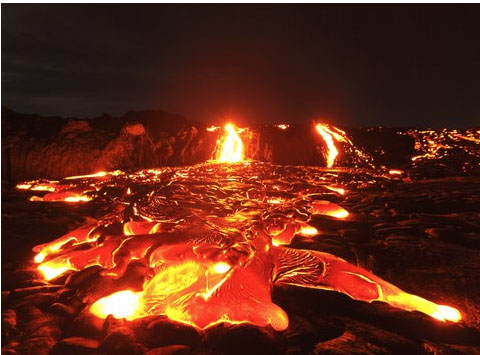
UPDATE 5/11/2018: A week after the Kilauea volcano on Hawaii’s Big Island began sending smoke and gas into the air and opening fissures in the ground along the volcano’s slopes, officials worry the worst is yet to come with a major eruption possible. The lava level in Kilauea’s main crater Halemaʻumaʻu continues to recede at an alarming pace and rockfalls from the crater walls have generated small ash clouds. If the lava level drops below the underground water table, it could trigger a much more violent explosion, sending giant plumes of ash up to 20,000 feet in the air and projectiles the size of refrigerators tumbling down its slopes, according to the United States Geological Survey (USGS). The government agency says it could erupt in a matter of days or weeks. During the last major eruption of Kilauea, in 1924, the ejection of ash and large boulders continued in a series of eruptions that lasted around two weeks and ash fell as far away as Hilo, today home to one of the island’s two major airports. The USGS is advising those in the area to read its guidelines online about how to mitigate the effects of volcanic ash.
So far, some 2,000 people have been evacuated from the communities of Leilani Estates and Lanipuna Gardens, as fifteen individual fissure vents in the ground spewed lava hundreds of feet in the air and released noxious sulfur dioxide into the air. Thirty-six structures, including over two dozen homes, have been destroyed and around 117 acres of land is still covered in lava, according to a report from Hawaii County’s Civil Defense. Even as volcanic activity in the East Rift Zone has quieted down, the hazardous fumes in the air has rendered entire communities off-limits. Officials indefinitely closed the Hawaii Volcanoes National Park to the public on Friday. Officials still say that the most hazardous effects of any larger eruption should be limited to the relatively sparsely populated area around the volcano.
As of right now, popular resorts such as the Four Seasons Resort Hualalai, Mauna Lani Bay Hotel & Bungalows, Mauna Kea Beach Hotel, Fairmont Orchid, and Hilton Waikoloa Village appear to be operating as normal—they’re on the island’s western coast, about 100 miles from Kilauea. While both of Big Island’s airports—Hilo and Kona—remain open and flights haven’t been largely disrupted by ash clouds yet, it’s worth checking with your tour operator or hotel to learn of any disruptions before you travel as conditions could change quickly. Hawaiian Airlines announced that guests traveling to/from/via Hilo or Kona airports between May 3 and May 13 can make a one-time change to their reservation without any of the associated fees.
Original story published May 3 continues below:
Hundreds of magnitude 2.0 to 4.0 earthquakes—250 in the last 24 hours—have been rocking Hawaii’s Big Island near the Kilauea volcano, indicating that the world’s most active volcano is living up to its name. The United States Geological Survey says that an increase of lava bubbling up to the surface is the likely scenario here. Travelers heading to the Big Island, or any of the Hawaiian islands, should be warned of the impact of the volcano’s heightened activity, but at this point it shouldn’t prevent you from taking your much needed beach vacation.
So far, the USGS expects the lava (should it come to the surface) to impact the Big Island’s East Rift Zone, or southeastern tip below Hilo. According to the government agency, lava is already flowing under the ground of Highway 130, the mostly residential area’s main thoroughfare. There are a number of vacation homes in the area, so be sure to check on conditions with your host if your stay is occurring in the next week. The area is preparing for evacuation, the mayor’s office reports, should the lava burst up to the surface, but there’s also no way to pinpoint exactly where the lava would erupt. So far, none of our Readers’ Choice Award-winning resorts are reporting any disruptions, as they’re all located relatively distant from the volcano, on the northwestern edge of the Big Island.
The main impact to tourists will be access to Hawaii Volcanoes National Park, about 15,600 acres of which is closed to visitors. “The recent eruption changes and increased seismicity around the East Rift Zone and Pu‘u ‘Ō‘ō vent may threaten land and the community outside the park. Most of the park, which is 333,308 acres in size, remains open,” said park superintendent Cindy Orlando in a statement Tuesday.
Kilauea’s status as the most active volcano in the world—it’s been continuously erupting since 1983—is part of the tourist draw to the Big Island. Its eruptions are often slow and stunning. One such eruption even created a lava waterfall last year, pouring 1,600-degree glowing, melted rock into the Pacific. While the Pu‘u ‘Ō‘ō vent (where this eruption is stemming from) is in that closed acreage, the actual summit of Kilauea is still open to the public. Its main crater, Halema‘uma‘u, just saw a surge in lava, to the point where some has been spilling out the top, and is best seen from the Jaggar Museum overlook, the National Park Service says.
This is a developing story and has been updated.

Leave a Reply